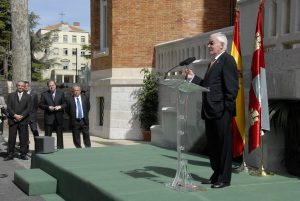*Source: “Historia del Palacio de la Isla de Burgos (1883-12010)” de Isaac Rilova Pérez
The “Palacio de la Isla”, summer residence of The Muguiro family
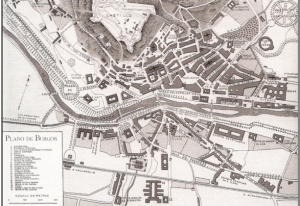
In 1833, Burgos reached the status of provincial capital. The city of Burgos carried out a remodelling of the urban environment under the auspices of the Minister of Public Works, Javier de Burgos. It is worth mentioning, that the building of the Provincial Council Palace and the awarding of a Territorial Court to Burgos.
On a military level, in 1837 a General Command was created, which, years later, became the General Captaincy, whose high command was located in the Cordon House in 1846. Because of this, a large number of civil servants and military personnel came to Burgos. In addition, the arrival of the railroad and the incipient industrialization favored the arrival of laborers, day laborers and servants, thus the the population of the city increased enormously.
It is also noteworthy, the demolition of the wall immediately next to the Santa María gate. This gave rise to a fast consolidation of the “Paseo de la Isla”, named like this because it was an island, between the Arlanzón River and the bed of a mill, which is currently covered.
In this context, although in winter the climate in Burgos is cold, in summer the temperatures are warm and nice, so that people from Madrid, such as Mariano Tomás de Liniers y Sarratea and Juan José Muguiro y Cerragería, considered the city appropriate to spend the summer seasons. Therefore they acquired various properties in the city. Thus, Mariano Tomás de Liniers y Sarratea bought a piece of land in the “Huertas de San Pedro” and Juan José Muguiro acquired the convent of San Francisco and built in the “Huerta de la Trinidad”.
At this time, The Liniers and The Muguiro families were often related families and representatives of the Madrid bourgeoisie settled in Burgos.
On the part of The Liniers Family, Santiago Liniers y Gallo-Alcántara, I Conde de Liniers was who built the family’s palace on Lavadores Street in 1879.
Concerning to The Muguiro family, Juan Muguiro y Casi was who started the construction of the “Palacio de la Isla, between 1882 and 1883.
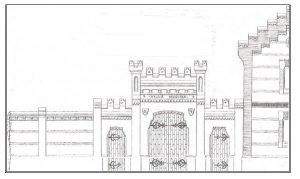
Already in 1881, Juan Muguiro y Casi started his plans for the construction of the Palace. To this end, he purchased an estate on the “Paseo de la Isla” whose owner was María Rojo Ortiz, a widow and native of Burgos. Once the documents of sale were signed, Muguiro’s lawyer, Juan García Sierra, went to the Town Hall to request the building permit, which was granted by the Works Section of the Town Hall in 1882.
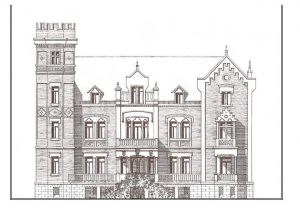
On January 16, the construction of the building began. At the beginning of December 1883, the Palace was completed, excepting the garages and the stables, which were finisehd in 1884. In 1885, specifically on 25 November, King Alfonso XII died.
The “Palacio de la Isla” and Franco during the Civil War (1936-1939)
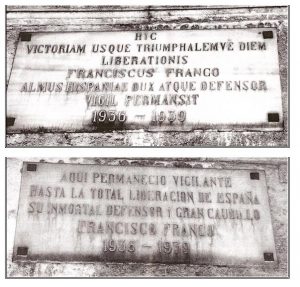
On July 17, 1936, the so-called ‘National Uprising’ broke out in Africa. The next day the uprising spread over the entire peninsula. Afterwards, once the rebels controlled much of the national territory, they began to organize themselves as a new military state. But it was necessary to appoint the general who was to hold the sole command, so on September 21, 1936 a meeting was held in Salamanca for this purpose. The generals choose Franco.
During the war, The Franco family settled in the Palace, but after it ended in 1939, they returned to Madrid.
The Palace was acquired by the local government and the council from Mrs. María Francisca Muguiro y Cerragería, however, it was established that it would serve as the residence of the ‘Head of State’ during his stays in Burgos. These occurred every year during the summer period until 1961.
There are evidences of Franco’s stay in the Palace, like the two tombstones fixed on both sides on the lintel of the entrance door, with inscriptions in Latin and Spanish.
The “Palacio de la Isla”: From the post-war period to the democratic period (1940-1975)
Between 1940 and 1960, the Franco regime was characterized by a repressive and autarchic government.
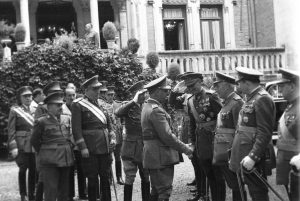
In the following years, Franco visited the city of Burgos during the summer, in order to attend some important events such as the Council of Ministers (1947), the closing of the IV National Games of the Youth Front (1948) and the Inauguration, in 1949, of Cellophane Española. It is also noteworthy, the inauguration of the monument to the Cid Campeador (1955), the inauguration of telephone services in twenty-eight villages in Burgos (1956), as well as the inauguration of a new blocks of flats (1957) and the inauguration of the new water supply to the city (1959).
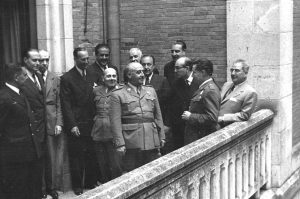
From 1960 onwards, the ‘Stabilization Plan’ was launched, ushering in an era of political openness and social change that marked the end of autarchy and state interventionism. At that time, the Palace was ceded to National Heritage as the seat of the “Museo del Caudillo”.
The “Palacio de la Isla” in the pre-autonomic stage (1976-1938)
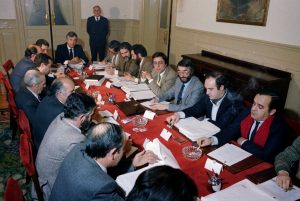
After Franco’s death in 1975, Juan Carlos I was proclaimed King in a political context of great uncertainty. He initiated a programme, known as “Reforma”, which aimed for the transition from a Francoist to a democratic system. Likewise, an autonomic process was initiated, whereby the right to autonomy of nationalities and regions was recognized.
On June 30, 1978, the “Palacio de la Isla” became the provisional seat of the General Council of “Castilla y León”. Finally, in 1983, the “Junta de Castilla y León” returned the keys of the “Palacio de la Isla” the local government and the council.
The “Palacio de la Isla” in the last twenty-five years (1983-1998)
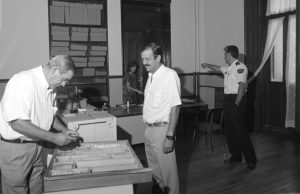
On August 17, 1990, the Burgos Police Station was devastated due to a terrorist attack by ETA. As a result, it was necessary to find a new temporary location for the police services. This location was the “Palacio de la Isla”. Therefore, on August 19, it became the new Police Station.
Later, in 1993, the Archives Recovery Service was located in the Palace and, in 1996, the Edelweiss Speleological Group.
Towards the establishment of the “Instituto Castellano y Leonés de la Lengua” (1998-2008)
In the year 2000, the “Instituto Castellano y Leonés de la Lengua” was born in the cloister of the Abbey of Santo Domingo de Silos, thanks to the personalities from politics, culture, university and business who gathered there to support the birth of this new organization. Its work would consist on promoting cultural activities directly linked to Spanish language, its study and dissemination.
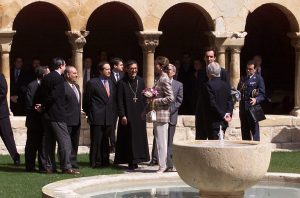
At the beginning, the “Instituto” was located in the Royal Abbey of San Agustín, but in 2005, the project to adapat the “Palacio de la Isla” and convert it into the seat of the “Instituto Castellano y Leonés de la Lengua”, began.
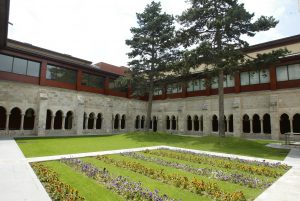
The “Palacio de la Isla”, headquarters of “Instituto Castellano y Leonés de la Lengua”
On April 25, 2008, the “Instituto Castellano y Leonés de la Lengua” was installed in the “Palacio de la Isla”. The layout of the new Palace as the language institute would be as follows:
On the ground floor there is an exhibition hall, an information point, a council hall, an assembly hall and a space for new technologies. Efforts have been made to maintain the original style as much as possible, in walls, ceilings and floors.
On the first floor, we can find the management, administration and cultural promotion offices, as well as the library and the Spanish Epigraphic Archive.
On the second floor, in addition to the management, there is a research department and training rooms.
